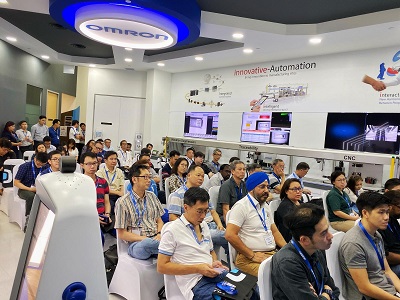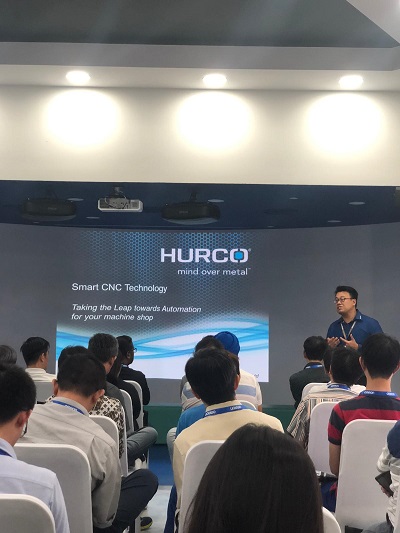Automation has gone from being an opportunity, to a possibility, and now to a reality in manufacturing. The rise in automation and modern technology can take CNC machining to a new level. To demonstrate this, Omron Electronics Pte Ltd and Hurco (S.E. Asia) Pte Ltd worked together in presenting a live working demonstration of the digitisation of a precision parts manufacturing process - integrating advanced CNC machine, during a seminar organised by Omron in Singapore.

Automated machining
According to Lieu, the seminar answers the challenges of high mix, low volume production, lean factory and even lights out factory concept. “Working closely with Hurco, we have set up a live digitisation process demo of precision part manufacturing. We focused on parts that can be fully automated for machine tending and parts feeding to CNC machine. In this way, we show how companies can leverage on the ready and available technologies to embark on digitisation journey to improve productivity and quality.”
Wai Yip explained its role in the seminar. “We provide the perspective from a machine tool builder in integrating automation into a machine shop. We hope to share our knowledge on the practical matters relating to CNC machine tending, to bridge the knowledge gap between automation and actual CNC programming/machining,” he said.

Lieu described Hurco as a strong provider of CNC technology. “I am looking at how to help a customer do the last mile of automation. When I say last mile, it means they may still need a human to physically deliver the workpiece and load inside the CNC machine. It is a very simple but mundane task. We have the technology to help customer connect to the system and bring the right parts, track this part to be brought to the right machine. And we need a partner who can help us streamline customer's business processes, creating higher productivity and greater efficiency in a digital world.”
The idea of automated machining is to have as few human hands on the workpiece as possible, and to reduce the labour and setup time required to get work started, Lieu added. Thus, ensuring work proceeds without disruption. Automating some of the processes you’re already familiar with will enable customer to create new products, which they weren’t able to do before. That includes developing more elaborate designs, as well as harnessing new manufacturing techniques.
Wai Yip further said the seminar does provide them with an opportunity to network with a new group of CNC machine users and learn from other vendors supporting this industry transformation towards smart manufacturing. He mentioned, “The key purpose though, is to explore partnership opportunities to integrate automation solutions to our CNC machines so that we can help increase the productivity of our customers’ shop floor.”
South East Asia’s industrial automation
Lieu confirmed that the degree of maturity and phases of digital development differs significantly within and between countries. “For instance, Singapore’s Smart Nation and Committee for the Future Economy initiatives, Malaysia’s launch of the world’s first digital free trade zone, and the Thailand 4.0 initiative. Many of these initiatives are supported by the government. They offer incentives to spur the private sector to advance and transform. These three countries are in the transforming stage and they will help sustain and enhance the automation landscape,” he remarked.
“On the other hand, Vietnam and Indonesia are fast catching up. Especially Vietnam in recent days are benefiting from electrification. It has made major progress in developing infrastructure and is fast becoming a major centre for electronics and other manufacturing. Meanwhile, Indonesia is the biggest economy in South East Asia, with almost USD$1 trillion GDP and their growth is pretty tremendous. They have the potential to grow fast, “commented Lieu.
Common to all societies in Asia and elsewhere is, however, the increasing importance of digital economy transformation, a development which typically is directed by larger cities with the most effective interfaces with international innovation, finance and access to human talent.
Wai Yip noted, “Business owners and factory managers will look at an earlier adoption of automation in their manufacturing process, even during the initial machine investment stage. The adoption of automation is largely seen to improve productivity and will allow business to expand and grow at a faster pace.”
Machine automation
Faced with ever-increasing cost pressures and demands for improved performance, machine builders are actively seeking new automation solutions with improved cost/performance ratios. In response to these demands, machine builders and control equipment vendors must work together to deliver the automation systems demanded, and how to successfully integrate the multiple power and control subsystems and components.
“It has been an enriching experience partnering with Omron for the first time in this seminar,” said Wai Yip. “We were able to explore the various solutions provided by Omron while sharing our perspective on CNC machining. This partnership created a hands-on opportunity for our engineers (from both side) to work together and integrate the Omron TM12 Cobot to our Hurco VM10i machining centre for machine tending operations. Practical matters such as Cobot teaching and movement, end-effector design, parts clamping & fixturing, CNC programming were addressed by our engineers during the preparation process. We believe that there is a good opportunity to introduce and integrate Omron TM cobots as a “fuss-free”, first step automation solution for existing and new Hurco machines,” he added.
Wai Yip point out the effective adoption of multiple machine automation depends on several factors such as type of parts, machining time and the production process, and would require a larger investment in both financial resources and human capital. With the increasing trend of high-mix, lower volume work, machining work has become more challenging to automate comparing to traditional mass production work.
“Our strategy is to work with our customer to adopt automation for machine tending at the individual machine level to improve their productivity immediately. This would solve their immediate labour shortage issue, and free up time for their experience workers to work on more complicated and value added jobs. Businesses could explore connecting multiple machines and devices at a later stage, when they have gained a better understanding on how their production process could be improved further with enhanced level of automation with MES and OEE systems,” he declared.
Automation reflects changing tasks
As automation become more and more real in manufacturing, data points are being gathered to project how these technologies will change business and improve the living standards of people in South East Asia.
“Our mission is clear and that is to improve lives and contribute to a better society. In many cases, automation creates safe, leaner, more efficient operations. Safe because it can reduce the health hazards of workers working in the factory. Efficiency facilitates new market opportunities and business growth, which in turn allow for expansion and job creation. That is also what we hope to achieve to allow the human to do more creative task,” Lieu expressed.
He conveyed that automation technologies allow companies to become more productive and create higher quality products in a safer environment for their employees. This allows them to be more competitive in the global marketplace and grow their businesses. And with that success comes more jobs.
Ultimately, companies that use automation to improve productivity, quality, and worker safety are more competitive, allowing them to grow and support entire supply chains and communities.
By: Kathryn Gerardino-Elagio
Air Max 90 Ultra 2.0 Essenti













